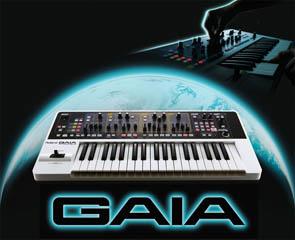Roland Releases GAIA Battery-powered Synthesizer(ShackMan | Posted 2010-06-24)  Roland is going back to its roots with new GAIA synthesizer, loosely based on the old SH-1000 synthesizer, and that's exactly where the name comes from. Gaia (or Gaea) is the name for the Greek goddess of the Earth and all the things that grow and live in it, so this synth is packing some old school features with some very new technology.
 The whole package has a very Juno-esque feel to it, which is no surprise coming from Roland. They've also updated their D-Beam laser sensor on this synthesizer so that it can control various parameters on the synthesizer. Fans of the noisemaker's sound on the Roland Juno-G and other boards will be glad to know that it's still keeping it's swirling FM sound as well. Adding to the list above, the GAIA will also feature a Bit Crusher, Arpeggiator, and a Hold feature that can sustain any note, arpeggio, or chord while you play around it. This is the kind of synth that will appeal to the dance artist as well as the progressive player listening to Jordan Rudess and Rick Wakeman. My only complaint is that 37 keys seems a bit small for the $700 street price, although I suppose the layout and the all-analog signal path could be a pretty nice trade-off for some. James Rushin is a bassist, keyboardist, writer, and composer living and working in the Greater Pittsburgh area. He has performed with Selmer artist Tim Price, Curtis Johnson, guitarists Ken Karsh and Joe Negri, and his compositions have been featured at West Virginia University and Valley Forge Christian College. His contest winning essays and short stories have seen publication in and around the Tri-State area. Feel free to e-mail James with comments, questions, concerns, or contrasting opinions at james.rushin@musicgearreview.com.
|
|

